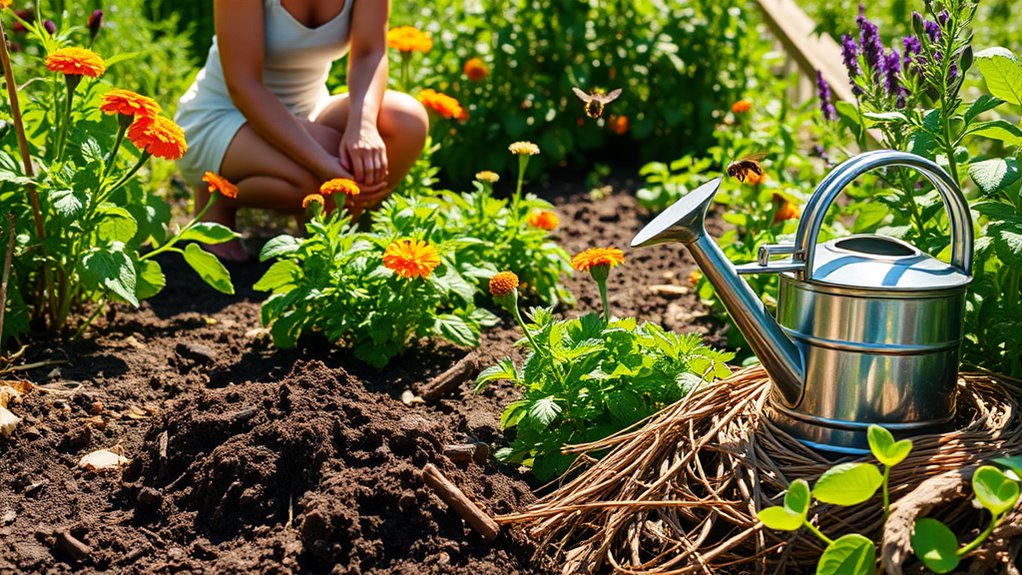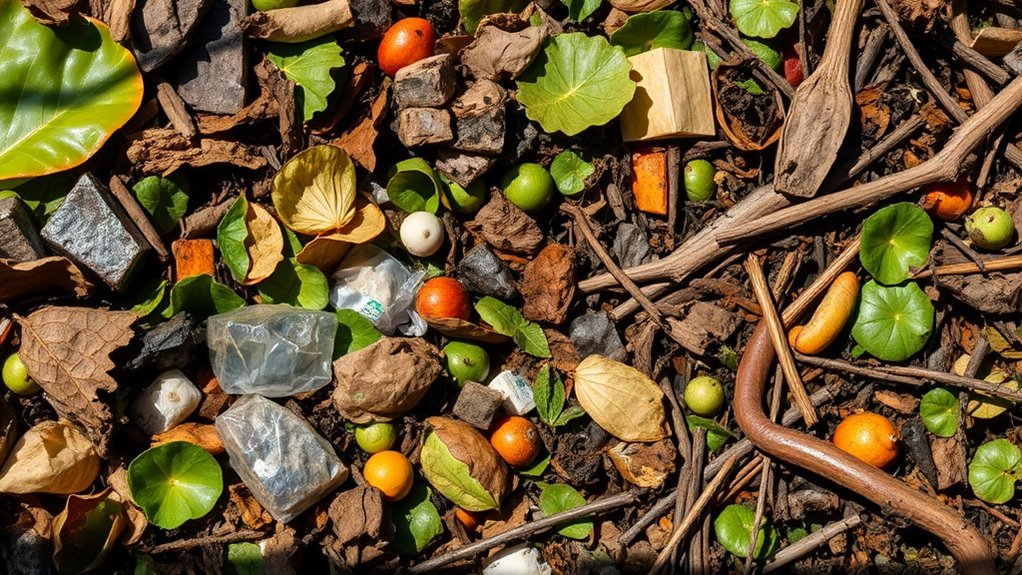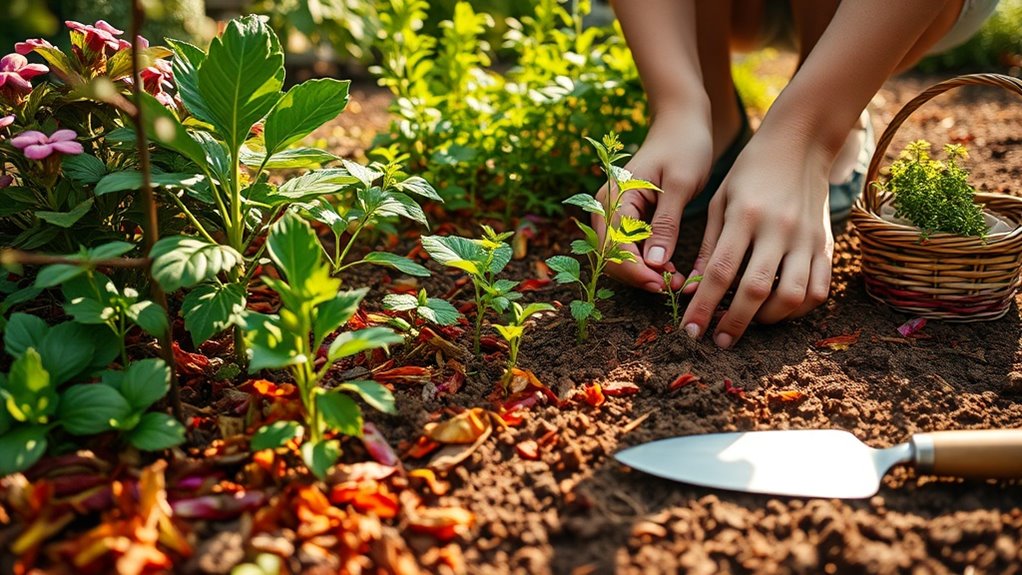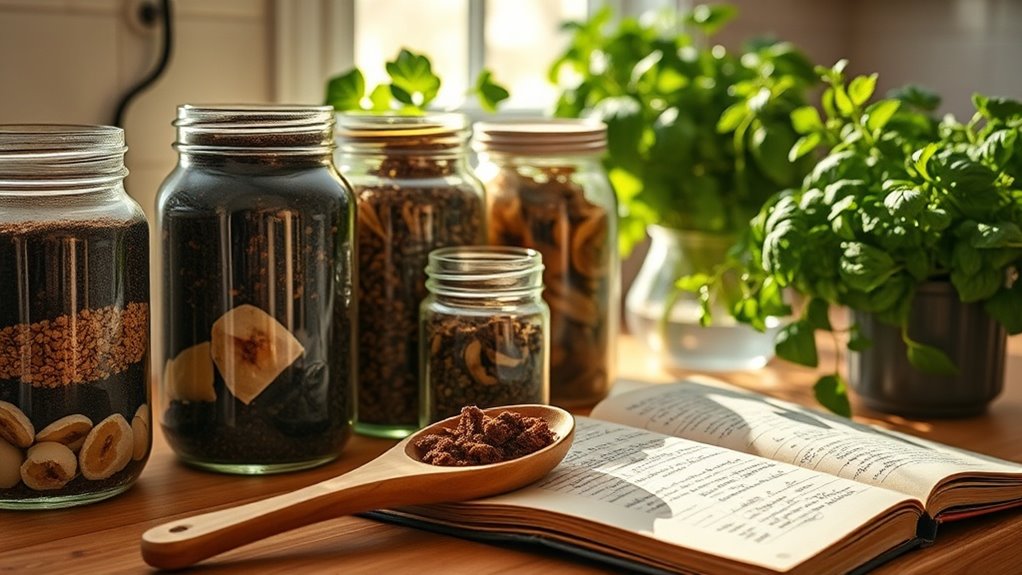Daily Habits That Keep Your Garden Healthy Without Chemicals
Just like a well-tended orchestra, your garden thrives on daily habits that promote its health without the need for chemicals. By making small adjustments to your routine, such as watering at the right times and encouraging beneficial insects, you can create a flourishing ecosystem. But how do these practices intertwine to bolster your garden’s resilience and vitality? Explore the essential steps to cultivate a thriving, chemical-free garden.
Key Takeaways
- Water your garden early or late to minimize evaporation and reduce the frequency of watering.
- Incorporate compost and organic matter to enrich soil naturally and improve plant resilience.
- Rotate crops regularly to enhance soil fertility and disrupt pest life cycles.
- Attract beneficial insects by planting diverse flowers like marigolds to manage pests naturally.
- Apply organic mulches to retain moisture, suppress weeds, and regulate soil temperature.
Watering Wisely
How do you ensure your garden gets the right amount of water without relying on chemicals?
Start by developing a natural garden routine. Water early in the morning or late in the afternoon to minimize evaporation.
Use a soaker hose or drip irrigation for efficient watering, delivering moisture directly to the roots. Monitor soil moisture by checking a few inches down—if it’s dry, it’s time to water.
Mulching around plants helps retain soil moisture, reducing the need for frequent watering. Lastly, consider rainwater harvesting; it’s an eco-friendly way to provide hydration and promote a thriving, chemical-free garden. Rainwater gardens can help you effectively manage water collection while enhancing the sustainability of your garden.
Practicing Crop Rotation
Practicing crop rotation is a simple yet effective way to boost your garden’s health.
By changing the types of plants you grow in specific areas each season, you can improve soil fertility and reduce pest and disease issues. Additionally, rotating crops can enhance the growth of companion plants that support your tomatoes and peppers, helping to maximize their yield and flavor.
In the following sections, you’ll learn about the benefits of crop rotation and strategies to implement it successfully in your garden.
Benefits of Crop Rotation
While many gardeners might overlook crop rotation as merely a traditional practice, it offers significant benefits that can enhance your garden’s health and productivity.
Here are three key advantages of implementing crop rotation:
-
Soil Health: Different crops contribute unique nutrients back into the soil, improving overall fertility and structure.
-
Pest Management: Rotating crops disrupts pest life cycles, reducing infestations without the need for chemicals.
-
Disease Prevention: By changing plant families, you minimize the risk of soil-borne diseases that thrive on specific plants.
Effective Rotation Strategies
To maximize the benefits of crop rotation, it’s essential to develop effective strategies tailored to your garden’s needs.
Start by grouping plants into families, rotating them yearly to prevent soil depletion and pest buildup.
Consider a three- to four-year rotation cycle, alternating heavy feeders like tomatoes with light feeders such as lettuce.
Keep a garden journal to track what you plant where, making it easier to plan future rotations.
Don’t forget to incorporate cover crops during off-seasons; they enrich the soil and control weeds.
This strategic approach fosters a balanced ecosystem, ensuring your garden thrives without chemicals.
Encouraging Beneficial Insects
Encouraging beneficial insects is key.
Here are three effective ways to attract these helpful allies:
-
Plant Diverse Flowers: Include a variety of flowering plants like marigolds and daisies, which provide nectar and pollen.
-
Provide Habitats: Create shelters using rocks, logs, and native plants to offer refuge for beneficial insects.
-
Avoid Pesticides: Skip chemical sprays; they harm beneficial insects and disrupt the ecosystem. Additionally, employing eco-friendly pest control methods can further support the balance of your garden’s ecosystem.
Maintaining Soil Health
To maintain healthy soil, you need to focus on a few key practices. Incorporating compost enriches the soil with nutrients, while rotating your crops prevents nutrient depletion and pest buildup. Additionally, using mulch helps retain moisture and suppress weeds, creating a thriving environment for your plants. Furthermore, adding natural tricks like cover crops and organic fertilizers can significantly improve soil structure and fertility.
Composting for Nutrient-Rich Soil
Ever wondered how composting can transform your garden into a thriving ecosystem?
By creating nutrient-rich soil, you enhance your plants’ health and resilience.
Here’s how to start composting effectively:
- Collect Kitchen Scraps: Use vegetable peels, coffee grounds, and eggshells to feed your compost pile.
- Add Yard Waste: Incorporate dry leaves, grass clippings, and small branches for balance.
- Turn Regularly: Aerate your compost every few weeks to speed up decomposition and prevent odors.
With these simple steps, you’ll enrich your soil naturally, promoting a healthier garden without chemicals.
Happy composting!
Crop Rotation Benefits
One powerful technique for maintaining soil health is crop rotation, which involves changing the types of crops you grow in a particular area each season.
By alternating crops, you help prevent soil depletion and reduce pest and disease buildup.
Different plants have varying nutrient requirements and root structures, which means rotating them can enhance soil structure and fertility.
For example, planting legumes after heavy feeders like tomatoes can naturally replenish nitrogen levels.
Additionally, this practice can break cycles of pests and diseases specific to certain plants, leading to healthier crops and a more resilient garden ecosystem.
Implement crop rotation for long-lasting benefits!
Mulching Techniques Explained
Mulching plays a vital role in maintaining soil health and enhancing your garden’s overall productivity.
By applying mulch, you can improve moisture retention, suppress weeds, and regulate soil temperature.
Here are three effective mulching techniques you can use:
- Organic Mulch: Use materials like straw, wood chips, or shredded leaves to enrich soil as they decompose.
- Inorganic Mulch: Consider stones or plastic sheeting for long-lasting weed control and temperature stability.
- Living Mulch: Plant cover crops like clover to protect soil and add nutrients while growing.
Implement these techniques to boost your garden’s health naturally!
Monitoring for Pests and Diseases
How can you ensure your garden remains vibrant and healthy? Regularly monitoring for pests and diseases is crucial. Take time each week to inspect your plants closely.
Look for signs like discolored leaves, unusual spots, or holes. Don’t forget to check the undersides of leaves, where pests often hide.
If you spot any issues, identify the culprit early to prevent spread. Encourage beneficial insects, like ladybugs, to keep harmful pests in check. Additionally, be aware of common garden diseases, as early detection can save your plants from extensive damage.
You can also use traps or barriers to protect your plants. Staying vigilant helps you maintain a thriving garden without resorting to harmful chemicals.
Composting and Mulching Regularly
Composting and mulching regularly enriches your soil and helps retain moisture.
Here’s how to get started:
-
Create a compost pile: Use kitchen scraps, yard waste, and other organic materials to create nutrient-rich compost.
-
Apply mulch: Spread a layer of organic material like straw, wood chips, or shredded leaves around your plants to suppress weeds and maintain soil temperature.
-
Turn your compost: Regularly aerate your compost to speed up decomposition and improve soil structure. Incorporating odor-free composting techniques can further enhance your composting experience.
These practices keep your garden thriving!





